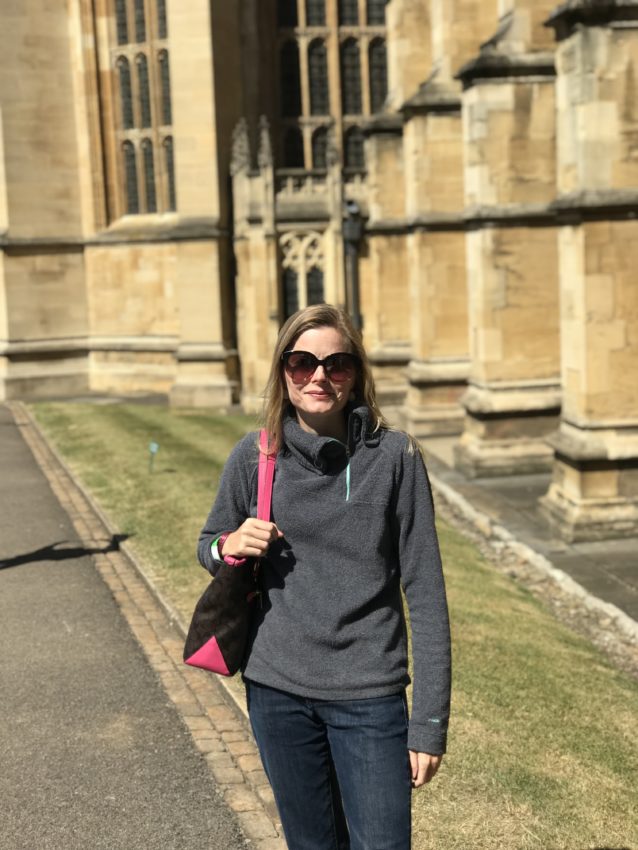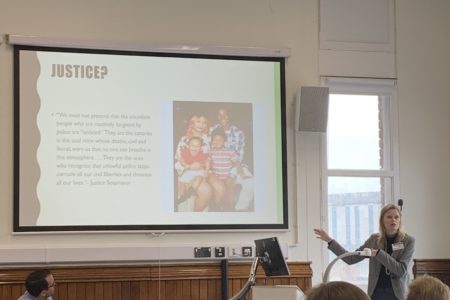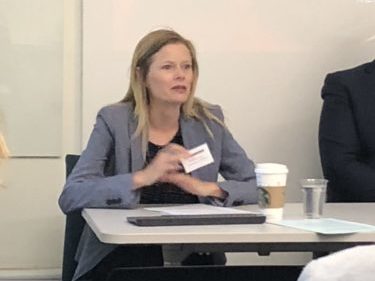
Share On Social!
Kendra Gage starts off all her new classes addressing one obvious fact: she’s white.
That’s because Gage is a professor at the University of Nevada, Las Vegas (UNLV) who teaches African American studies, focusing on the Civil Rights Movement and addressing racism in modern America.
Gage believes in addressing her whiteness because she wants students to be aware of implicit bias─ stereotypes that affect our understanding and decisions about others beyond our conscious control─in the classroom. She feels it’s her role as an educator to highlight her own implicit bias and allow students to question their own biases.
“My very first lecture in class, I say, ‘This is who I am. I am white.’ I mean, I can’t hide behind that, so I do address it,” Gage said.
That is what has helped drive her teaching and helps her address race in the classroom.
Background as a Teacher in Civil Rights
Gage wasn’t always sure she wanted to be a professor.
She got her undergraduate and master’s degrees in history. But she was tired of school and didn’t think teaching was for her.
Despite her uncertainty, Gage considered teaching because she enjoyed interacting with others.
“I was given an opportunity to teach a class at the University of Wyoming and I loved it. I fell in love with the students, I fell in love with the whole process of teaching. It was really invigorating, and my students were amazing and continue to be amazing,” Gage said.
The experience led Gage to pursue a Ph.D. in history from UNLV, where she currently teaches.

As Gage focused her research on the Civil Rights Movement, she frequently taught on that subject. She also teaches several classes related to how race has shaped history and today.
“This semester, I’m teaching a new class called Rise and Revolution that’s looking specifically at the issues of today and conceptualizing how we’re still at a moment where we’re dealing with a pandemic of racism and that we’re still in this moment of Black Lives Matter. I also teach another class that’s designed for our seniors, the senior capstone class, where they look at modern issues and they write about those in lengthy papers,” Gage said.
Gage is able to make historical lessons relevant due to society’s ongoing issues over race.
“Many issues that were occurring 50 years ago are still plaguing us today,” Gage said.
That’s why Gage makes race the first issue she discusses in class.
Race and Diversity in the Classroom
Race is easy to discuss at a school where diversity is abundant and celebrated, according to Gage.
UNLV is one of the most diverse universities in the country. As of Fall 2020, UNLV’s student body was 29.8% Latino, 15.6% Asian, 8.1% Black, 10.4% multiracial, and 30.8% white.
“My student population is primarily students of color and that makes it really nice to teach that student population base,” Gage said.
That wasn’t the case at past universities where Gage has taught. At those institutions, students would question Gage’s teaching about civil rights and argue that events had occurred differently.
“Unfortunately, students are given a sugar-coated version of history and they’re not really told what has happened. There really is this triumphalist narrative that we have, that once the Civil Rights Acts are passed, that there is a level playing field. And we know that that’s not the case at all. Especially in education, there are so many educational gaps for students of color, because of where their schools are located and the resources that they have,” Gage said.
This is why Gage wants her students to address preconceptions and biases that they have.
And it’s easiest to start with herself.
Addressing Implicit Bias
People often don’t expect an African American studies professor to be white, according to Gage.
“I walk into the room and it’s not who they expect. I have to acknowledge my own race and say, ‘I am white. And I do teach this. And I think it’s really important for white professors to be addressing these particular issues as well, we can’t ignore these issues,’” Gage said.
Gage has always discussed implicit bias in the classroom, even before she knew what to call it.
“That’s something I’ve always done. I’ve always been aware of it. I was just aware that there are certain privileges that I had growing up. But there’s also other things that I can understand, too,” Gage said.
Her experiences growing up poor impacted her, but Gage recognized the privileges she had nonetheless.
“I’m a first-generation student and I grew up in a poor family. But I never had to worry walking into a store that they were going to follow me because they thought I was going to steal something. And I know that my experiences, even with school counselors, was different when I would walk in and they would ask, ‘Where are you wanting to go to college?’ Sometimes those conversations don’t happen when you look a different way,” Gage said.
Addressing bias is important for educators even beyond race, says Gage.
“I’ve heard people say, ‘Well, I’m not racist, so I really don’t need to address these particular issues.’ It’s not just about racism. There are implicit biases that are based upon class, and even if somebody has an accent, or their weight, or ability. The list goes on and on. Implicit bias is not just about race; it covers a spectrum of issues that I feel like all of us should be talking about,” Gage said.
Salud America! has a new action pack that is helping people identify implicit bias, reflect on it, and “rewire” bias toward more compassion for other people.
Teaching Anti-Racism
Along with teaching about implicit bias, Gage wants her students to learn about racism happening in the United States and how to actively fight against racism, also known as anti-racism.
“I used to say what we’re experiencing in America is covert racism, where it’s hidden, where there’s these little microaggressions that you might be experiencing every day. But within the past year, that’s become much more overt, where people have felt emboldened to say whatever they’d like to say. And we’re capturing a lot of that now on film,” Gage said.
Gage encourages her students to reflect on how race impacts them each day.
“I think one of the first steps is to really reflect on who you are and your position within society. I think a lot of us can quickly say, ‘I’m not racist,’ but we’re not reflecting on how that system of racism has played out in our lives and has led some of us to have more advantages than others,” Gage said.
A way that students can examine their race and privileges is through self-assessment.
“There’s a really great article by Peggy McIntosh called White Privilege: Unpacking the Invisible Knapsack. There’s an exercise that you can actually do called racial inventory, where you can fill it out and you give yourself a score of one to five,” Gage said.
McIntosh’s assessment offers statements such as “I can go shopping alone most of the time, pretty well assured that I will not be followed or harassed,” or “If a traffic cop pulls me over or if the IRS audits my tax return, I can be sure I haven’t been singled out because of my race.”
 Those who can answer yes to most of the questions are most likely experiencing privilege.
Those who can answer yes to most of the questions are most likely experiencing privilege.
Even younger students can learn from McIntosh’s article, according to Gage.
“It’s actually something that would be appropriate for probably fifth grade on, for those students to take this particular test to see that there are these huge differences,” Gage said.
Another thing that helps is having more teachers that reflect diversity. Gage always encourages her students to pursue teaching.
“We absolutely need more teachers of color,” Gage said. “And that’s a huge issue─ how do we recruit teachers? We underpay them, so you have to love what you do to be able to go into that field, but we really do need to have more teachers of color. Study after study, where if a student of color has a teacher of color, they do better on testing, they’re more likely to graduate, they’re more likely to attend school every day.”
What Her Children’s Teacher Taught Her
For Gage, an experience with her child’s school project showed how teachers can sometimes miss the mark.
“I remember years ago, my youngest child came home and she had to write about her hero. And I said, ‘Oh, who did you choose for your hero?’ And she said, ‘Oh, no, the teacher assigned me my hero.’ And her hero was chosen to be Andrew Jackson,” Gage said.

Gage’s children are of mixed race and are half Native, so this project came as a shock to her as Jackson was responsible for the genocide of Native Americans during his presidency.
Gage wishes the teacher had given students the opportunity to choose their own heroes.
“I think for a simple assignment like that, allowing students to go out and explore who their own hero is and then bring that into the classroom. Simple things like that, but to really address the curriculum and say, ‘Okay, who am I assigning? What are the types of assignments that I’m assigning? Are they more creative? Are they more written based?’ Really look at what you’re assigning and become more creative with those assignments. We know that when students can identify themselves in these projects, that they do much better with those particular assignments as well,” Gage said.
What Teachers Can Do
How can other educators acknowledge implicit bias and race in the classroom?
A commitment to diversity is the first step, Gage says.
“I encourage professors to put a diversity statement on their syllabus. And I know that’s really simple, but I’ve heard from other students that once they see that on the syllabus, they’re like, ‘OK, this class is good, this professor acknowledges what is going on.’ And that’s something very, very simple, and a lot of institutions have these already crafted, and you can copy and paste that onto your particular syllabus,” Gage said.
Even if what you teach doesn’t directly relate to race, acknowledging it is still important, according to Gage.
“I have heard others say, just amongst conversation, that it’s not something that they really need to address, they might be a professor in the sciences. And they say, ‘We don’t really deal with issues of race.’ And we know that that’s not true. If we don’t talk about race within the sciences as well, we’re missing an opportunity to connect with our students,” Gage said.
Another way that teachers can get involved is by making sure the content they teach comes from diverse sources.
“It’s important to really look at our curriculum and see who we’re assigning for some course readings. If they’re all people who are white men and that’s all they’re reading, that’s a problem and we need to diversify who we’re exposing young people to,” Gage said.
For educators who teach younger students, how you set up your classroom can make a big difference as well, even when schools are online.
“To even look at how you decorate your classroom, and who’s on the walls and who you’re prioritizing. I know that other people have flipped to some of these online formats, where they can decorate their room. And they’ve put up some really important people of color on their walls and change through them, so then when students log in, they’re looking for who’s new on the wall, and it gets them really excited. And they are sent to research and say, ‘Who is this? What did they do?’ And so it’s that interactive experience that you can do in the classroom, now in this online environment,” Gage said.
Gage is encouraged that the conversation about implicit bias and anti-racism is moving beyond the African American studies department.
“I feel like we’ve been a silo for a while where we’re like, ‘We need to be talking about implicit bias! We need to be talking about anti-racism and what we should be doing in the classroom!’” Gage said. “And so I’m really heartened to see that that other outlets are focused on this.”
Explore More:
Overcoming Harmful BiasesBy The Numbers
3
Big Excuses
people use to justify discriminatory behavior
This success story was produced by Salud America! with support from the Robert Wood Johnson Foundation.
The stories are intended for educational and informative purposes. References to specific policymakers, individuals, schools, policies, or companies have been included solely to advance these purposes and do not constitute an endorsement, sponsorship, or recommendation. Stories are based on and told by real community members and are the opinions and views of the individuals whose stories are told. Organization and activities described were not supported by Salud America! or the Robert Wood Johnson Foundation and do not necessarily represent the views of Salud America! or the Robert Wood Johnson Foundation.



